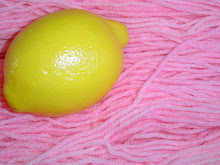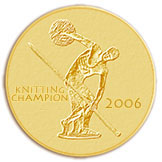New Spinning
 Yesterday I started spinning the singles for the cabled yarn I'm going to make for my Rosemarkie vest. (Remember the Merino and Kid Mohair cabled yarn I did last Fall? I'll be using that for one color and this for the other color and thought that since one yarn was cabled, the other should be too. I should probably spin up just a bit of this so I can work a swatch to double check that this is going to work.) OK, so as you can see, I've just barely gotten started here. The important thing to remember when you're doing a planned cable yarn is that you spin your singles S twist, rather than Z twist. This way you end up with the final twist in your yarn S twist which works better for Western knitting styles. OK, so that's easy you say, just spin counter clockwise on your singles. Well, yes, it is easy, except that you need to have a leader* spun S twist or your leader will unspin, fall apart, and you'll never get anything actually spun. And if you are maybe having a conversation with your 6 year old son about who is the coolest Sith Lord ever, you might not be thinking clearly about which direction your leader is spun and which direction the singles you are attempting to spin are going, and why that might not work. All you know is that the wheel is turning, the bobbin is winding on, the leader is falling apart in your hands, Darth Maul has the best lightsaber ever, but he gets cut in half (and so does his light saber) in the first movie, Count Dooku gets to be in two movies, but his lightsaber has a funny handle (looks sort of ergonomically "Retired Sith Lord Lightsaber Handle - easy on the joints and arthritis friendly" to me), but Darth Vader, while he really celebrates the whole Dark Side package, in the end, when Luke smacks him upside the head, he comes to his senses, kills the Emperor, balances the force, and is forgiven for the stupid mistakes he made when he was younger, and really, since we've all made some stupid mistakes when we were younger (alright, no, I never joined the Dark Side, but you know what I mean), I think he's a Sith Lord we can all get behind. I did eventually, figure out what was going on with my leader issues, spun up a quick S twist leader with a spindle and as you can see above, I've started spinning.
Yesterday I started spinning the singles for the cabled yarn I'm going to make for my Rosemarkie vest. (Remember the Merino and Kid Mohair cabled yarn I did last Fall? I'll be using that for one color and this for the other color and thought that since one yarn was cabled, the other should be too. I should probably spin up just a bit of this so I can work a swatch to double check that this is going to work.) OK, so as you can see, I've just barely gotten started here. The important thing to remember when you're doing a planned cable yarn is that you spin your singles S twist, rather than Z twist. This way you end up with the final twist in your yarn S twist which works better for Western knitting styles. OK, so that's easy you say, just spin counter clockwise on your singles. Well, yes, it is easy, except that you need to have a leader* spun S twist or your leader will unspin, fall apart, and you'll never get anything actually spun. And if you are maybe having a conversation with your 6 year old son about who is the coolest Sith Lord ever, you might not be thinking clearly about which direction your leader is spun and which direction the singles you are attempting to spin are going, and why that might not work. All you know is that the wheel is turning, the bobbin is winding on, the leader is falling apart in your hands, Darth Maul has the best lightsaber ever, but he gets cut in half (and so does his light saber) in the first movie, Count Dooku gets to be in two movies, but his lightsaber has a funny handle (looks sort of ergonomically "Retired Sith Lord Lightsaber Handle - easy on the joints and arthritis friendly" to me), but Darth Vader, while he really celebrates the whole Dark Side package, in the end, when Luke smacks him upside the head, he comes to his senses, kills the Emperor, balances the force, and is forgiven for the stupid mistakes he made when he was younger, and really, since we've all made some stupid mistakes when we were younger (alright, no, I never joined the Dark Side, but you know what I mean), I think he's a Sith Lord we can all get behind. I did eventually, figure out what was going on with my leader issues, spun up a quick S twist leader with a spindle and as you can see above, I've started spinning.In the comments yesterday, there was a great question about spinning sock yarn and the myth that handspun cannot hold up to socks. First of all, if you spin your sock yarn the same way you spin your shawl yarn, or your sweater yarn, no, it won't hold up. The beauty of handspinning is that I can spin my yarn to suit my purpose. For sock yarn I need a strong yarn that can take the wear and tear of being walked on and going into shoes. It needs to be a fairly fine yarn (anything over sport weight is too thick to wear with shoes, but thicker yarns do make great sleeping socks or slipper socks). There are several different ways I can get a yarn like this and I will use some or all of them, again depending on the exact end use I see for the socks.
Your first consideration should be fiber. What kind of wool are you going to use? Merino is soft but because of the fineness of the fibers, doesn't wear all that well. Wensleydale and Falkland were both suggested in the comments. I've never used either for socks so I can't personally recommend them, but they should both work well, with Wensleydale being the harder wearing of the two, but also probably coarser. (A lot of people swear by Blue Faced Leicester - BFL - for socks, again, I've never used it so I can't recommend it personally.) What I have used for socks is Romney, Gulf Coast Native Improved (GCNI), Border Leicester, and Coopworth. You'll notice that all of these wools are at least a medium grade and some are longwools. These wools, while not as soft as Merino, are strong and for the most part have a longer staple length. If you're concerned about softness, you could always blend a small amount of a softer wool with one of these more durable wool types. If you really want your socks to wear well, you want to add something to the wool. Commercial sock yarns tend to add nylon and while you can get nylon to spin with your wool, I prefer Mohair. Mohair wears like iron and can take the constant abrasion socks are subjected to. I use a Yearling Mohair - its stronger than Kid Mohair, but still soft - and have it blended in with the wools (15% mohair added by weight is what I use). Let me take a minute to discuss silk here. Yes, silk is strong. Silk is the strongest natural fiber. But this is strength in tensile weight (how much weight can you have pulling on it before it breaks), not abrasion strength. Socks are subjected to abrasion which silk doesn't deal with very well. This is why I don't usually add silk to socks.
OK, so you've got your fiber, now, think about how you're going to spin it. A three ply is stronger than a two ply, although I personally tend to do 2 ply sock yarn. Either way, you want a medium amount of twist - too little and yes, you'll have a soft, fluffy yarn but it won't be strong enough to knit tightly. Too much and the yarn will get coarse and wiry (this is particularly something to watch in the long wools). Finally, once its spun, the last thing you can do to determine whether or not your sock yarn will hold up is the knitting of the socks. I always knit my socks tightly. Its not always fun to work the gussets after the heel turn, but knitting them tightly increases the durability of the finished socks.
So, yes, you can spin your own sock yarn, and yes it can be quite durable. After all, mill spun yarns have been around a comparatively short time when you look at the history of yarn. People have been wearing socks for centuries and they certainly didn't have the time to be constantly darning them (although they did darn them when they wore out), so they would have spun the yarn to make it strong. Great question by the way Connie, thanks for the blog subject!
*A leader is a scrap piece of yarn tied around the bobbin of a spinning wheel that you use to start spinning. By allowing twist to build up in the leader, you can then place your unspun fiber near the end of the leader, they will spin together and as the twist enters your unspun fiber, it becomes a singles and then gets wound on the bobbin. To the best of my knowledge, you need a leader to spin singles on a spinning wheel, but you don't have to use one to spin on a spindle. With a spindle (since someone might ask), you just fold a bit of fiber back on itself, catch the fold on the hook and start spinning carefully. Once you have 12-18 inches, take it carefully off the hook and wrap it around the shaft of the spindle, making sure to overlap the end several times. Then bring it back up through the hook and spin as usual. I actually prefer to spin on spindles without leaders.
Labels: Rosemarkie, Spinning for Socks










4 Comments:
Ooh, ooh, I know this one! Here's the trick I was taught. If you use a leader that is a LOOP rather than a strand of yarn, it doesn't matter which direction you spin, it does NOT fall apart. So I make a loop of yarn about 2 feet in diameter (or more) and tie that around my bobbin (by pulling one end through the other twice), pull the whole thing through the hooks and orifice and I'm good to go. Solves all leader twist direction problems, I promise!
I love all the information you share. Your spinning just gets better and better and the knowledge ever expanding.~!
Thanks for the answer on the sock yarn. I might get some roving this weekend from my SD friends - they mix a lot of stuff - and if they don't have it, they can mix it for me.
I never tried a leader-less spindle. But then, I don't care for spindles, except for demos, so I don't use it much. Give me the wheel, anytime!!
Blessings
Hi neighbor!
I'm loving the roving from The Wollen Rabbit! I'm going to have to order some batts from them. By the way, very pretty lacey knitting.
Take care!
Post a Comment
<< Home